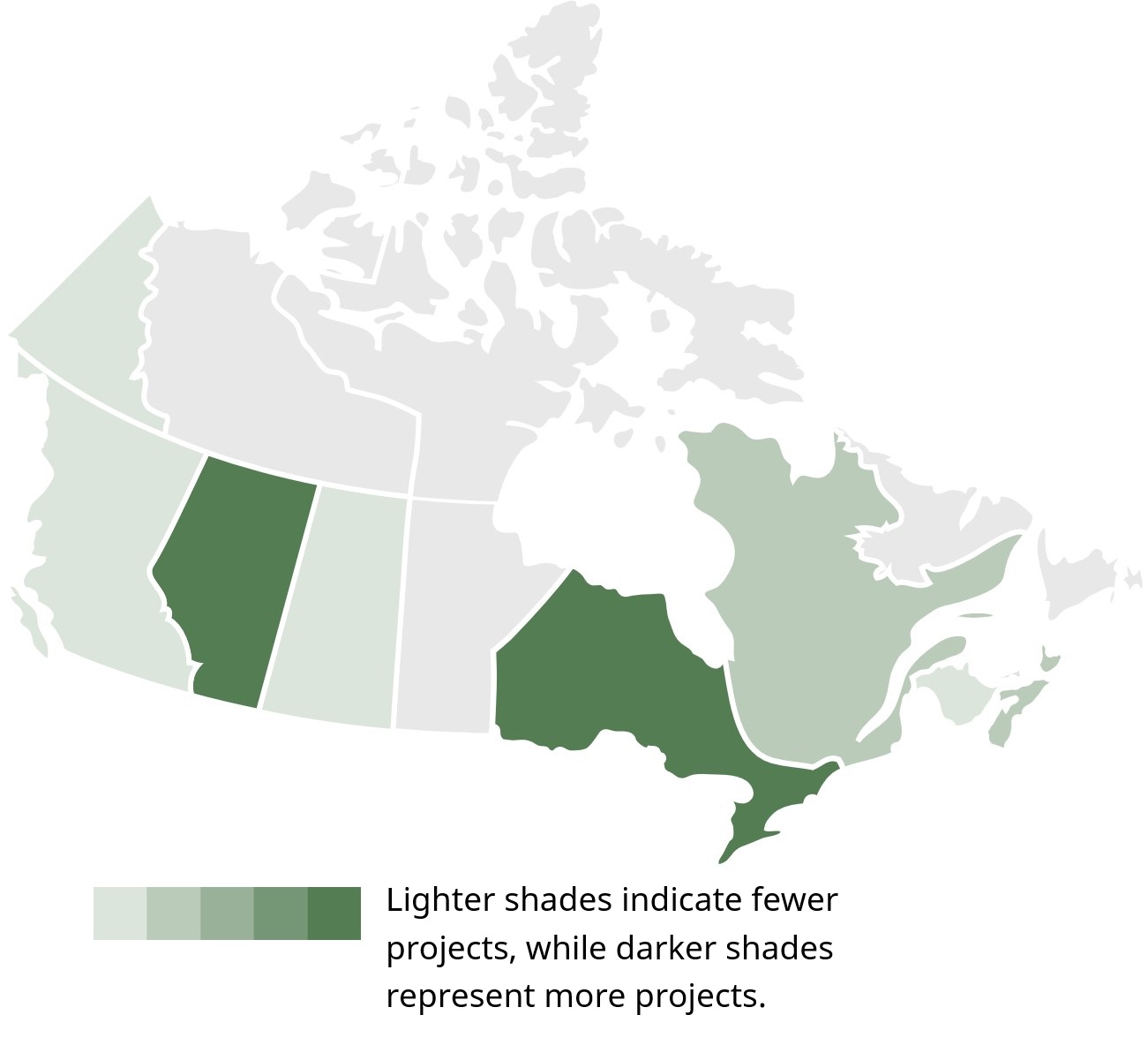Program descriptions
The Smart Grid Program (SGP) is a $100 million, five-year program (2018-23), led by the Renewable and Electrical Energy Division (REED) and Office of Energy Research and Development (OERD). It aims to accelerate the shift to a clean growth economy by optimizing electricity assets, boosting renewable generation, and enhancing power system reliability, resilience, flexibility, and cybersecurity. The program primarily funds public utilities.
The Emerging Renewable Power Program (ERPP) is a $200 million, eight-year program (2018-26), led by REED. It aims to expand commercially viable renewable energy sources, reducing greenhouse gas (GHG) emissions from the electricity sector. The majority of the funding was allocated to six deployment projects.
SGP and ERPP projects are spread across 9 jurisdictions

10
SGP deployment projects on proven smart grid integrated systems.
6
SGP hybrid projects with demonstration and deployment components.
6
SGP demonstration projects on near-commercial smart grid technologies.
6
ERPP deployment projects on new renewable power technologies: 3 geothermal, 2 tidal (1 cancelled), and 1 solar.
9
ERPP studies across all regions to advance knowledge and disseminate information.
Evaluation results
The SGP and ERPP have achieved all immediate outcomes and some intermediate outcomes
- Numerous projects have been implemented. However, regulatory barriers, technological issues, and the COVID-19 pandemic slowed program delivery and hindered achievement of targets.
There is a need to better understand and address the effects of business models and regulatory environments on project success.
- While the programs have made some progress, several intermediate outcomes and their targets are unlikely to be met. Progress toward long-term impact may be limited by the programs’ limited scale as compared to the extensive scope of the challenge (i.e., achieving net-zero emissions in Canada's electricity sector).
- Widespread dissemination of program information and results to encourage project replication and facilitate scale up will be key to program success.
The programs are relevant
The programs help the utilities sector to overcome key barriers in transitioning to clean energy systems.
Stakeholders are highly interested in expanding information and results dissemination.
Overall, the programs are efficiently designed. Staff have shown flexibility in adapting to changing circumstances.
- The programs deviated from their original plans to adapt to changing circumstances. Consequently, many projects were delayed and some cost more than initially agreed.
- The SGP’s “one window” design provided the opportunity to fund a greater range of projects, but hybrid projects were administratively burdensome.
- Collection of some performance data was inconsistent. There is limited information to determine progress for several indicators.
The program’s performance measurement approach has room for improvement.
Recommendations and Management Response Action Plan
| The Assistant Deputy Minister of the Energy Systems Sector (ADM ESS), in collaboration with the Assistant Deputy Minister of the Energy Efficiency and Technology Sector (ADM EETS), should continue to proactively work with federal, provincial, and territorial partners to develop strategies to better understand and address the impact of business models and regulatory environments on project success. |
Management has agreed to:
|
| The ADM ESS, in collaboration with the ADM EETS, should develop a consistent way to collect data annually on new job creation from funding recipients. This could include developing and providing a template similar to what is available for calculating GHG emissions reductions. |
Management has agreed to, where appropriate:
|
| To encourage project replication and facilitate scale up, the ADM ESS, in collaboration with the ADM EETS, should increase emphasis on sharing program and project-specific results with intended audiences and the broader public. |
Management has agreed to:
|
About the evaluation
- The evaluation was led by NRCan’s Audit and Evaluation Branch (AEB). It covered the period April 1, 2018, to March 31, 2023.
- The planning phase began in summer 2022 by AEB. The conduct and reporting phases were completed in fall 2024 by Prairie Research Associates, under the guidance of AEB.
- The evaluation was required to meet a Treasury Board commitment and Section 42.1 of the Financial Administration Act.
- Performed 6 Case studies.
- Conducted 28 interviews with 37 individuals.
- Reviewed similar programs in Canada and abroad.
- Reviewed over 200 internal documents and 34 external documents.